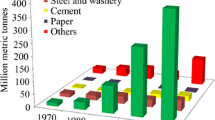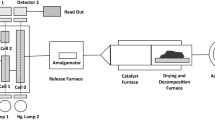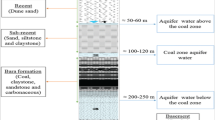Abstract
The term “quality of coal” specifies the properties and characteristics which influence its behavior and uses. In view of this point, this study conducted a comprehensive investigation on the major and minor properties of imported coal in the Tamabil area of Bangladesh through laboratory analysis. The major properties include sulfur content, moisture content, ash content, volatile matter, fixed carbon, and calorific value, whereas the minor properties include arsenic (As), chromium (Cr), cobalt (Co), copper (Cu), zinc (Zn), manganese (Mn), and lead (Pb). A detailed comparison was made between the obtained results and the standard values of the coal properties. A description of statistical correlations among the analyzed qualitative properties is also offered in this research. In addition, analysis of leaching and the combustion of coal revealed the possible modes of environmental degradation by imported coal. From the results, it can be observed that the imported coal contains a medium to high levels of ash content (23.38%), volatile matter (38.61%), and sulfur content (3.73%), whereas it contains a low level of fixed carbon (34.73%), and it has a low calorific value (5597.34 kcal/kg). The results also show a significant concentration of trace/minor elements, e.g., chromium—17.5 ppm, cobalt—2 ppm, copper—5 ppm, zinc—152 ppm, manganese—189.5 ppm, arsenic—52 ppm, and lead—4 ppm; this suggests that the imported coal is poor-grade lignite coal. The comparison of the obtained results with the standard values of coal properties also indicates the poor-grade and rank of the imported coal. It is obvious from the comparison that the concentrations of trace elements in this imported coal are much higher than the allowable standard limit for the environment. In conclusion, this research recommends that more attention should be paid to avoid the utilization of poor-grade coal and necessary steps must be taken to import good quality coal for safe and sustainable environment in the country.


Similar content being viewed by others
References
Bahar, M. M., & Reza, M. S. (2010). Hydrochemical characteristics and quality assessment of shallow groundwater in a coastal area of South-West Bangladesh. Environmental Earth Sciences,61, 1065–1073. https://doi.org/10.1007/s12665-009-0427-4.
Bhattacharya, M., Churchill, S. A., & Paramati, S. R. (2017). The dynamic impact of renewable energy and institutions on economic output and CO2 emissions across regions. Renewable Energy,111, 157–167.
Clarke, L. (1993). The fate of trace elements during combustion and gasification: An overview. Fuel,72, 731–736.
Conzemus, R., Welcomer, T., & Svec, H. (1984). Elements partitioning in ash depositories and material balances for a coal burning facility by spark source mass spectrometry. Environmental Science & Technology, 18, 12–18.
Eskenazy, G. M., & Valceva, S. P. (2003). Geochemistry of beryllium in the Mariza–east lignite deposit (Bulgaria). International Journal of Coal Geology,55(1), 47–58.
Finkelman, R. B. (1993). Trace and minor elements in coal. In M. H. Engel & S. A. Macko (Eds.), Organic geochemistry (pp. 593–607). New York: Plenum Press.
Font, O., Querol, X., Huggins, F. E., Chimenos, J. M., Fernandez, A. I., Burgos, S., et al. (2005). Speciation of major and selected trace elements in IGCC fly ash. Fuel,84(11), 1364–1371.
Hashan, M., Howladar, M. F., & Jahan, L. N. (2016). Sulfur concentration in imported coal around the Tamabil area, Sylhet, Bangladesh. International Journal of Environmental Monitoring and Analysis,4(1), 27–30. https://doi.org/10.11648/j.ijema.20160401.15.
Hashan, M., Howladar, M. F., Jahan, L. N., & Deb, P. K. (2013). Ash content and its relevance with the coal grade and environment in Bangladesh. International Journal of Science and Engineering Research,4(4), 669–676.
Howladar, M. F. (2012). Coal mining impacts on water environs around the Barapukuria coal mining area, Dinajpur, Bangladesh. Environmental Earth Sciences,70, 215–226. https://doi.org/10.1007/s12665-012-2117-x.
Howladar, M. F., Deb, P. K., Muzemder, A. T. M. S. H., & Ahmed, M. (2014). Evaluation of water resources around Barapukuria coal mine industrial area, Dinajpur, Bangladesh. Applied Water Science, 4(3), 203–222. https://doi.org/10.1007/s13201-014-0207-5.
Howladar, M. F., & Islam, R. (2016). A study on physico-chemical properties and uses of coal ash of Barapukuria Coal Fired Thermal Power Plant, Dinajpur, for environmental sustainability. Energy, Ecology and Environment. https://doi.org/10.1007/s40974-016.0022-y.
Imam, B. (2005). Energy resources of Bangladesh. Dhaka: University Grants Commission of Bangladesh.
Iyenger, M. S., Guha, S., Bari, M. L., & Lahiri, A. (1959). Proceedings of the Nature of Coal, CFRI, Jealgora, India, pp. 206–214
Kim, M., Kim, Y., Kim, H., Piao, W., & Kim, C. (2015). Enhanced monitoring of water quality variation in Nakdong River. Desalination and Water Treatment. https://doi.org/10.1080/19443994.2015.1049963.
Kuehn, W., & Kurzbach, H. (1992). The chemical composition of the coal ash in the White Elster basin with special emphasis on the titanium content. Braunkohle (Duesseldorf),44(1), 27–32.
Li, P., Qian, H., Wu, J., Zhang, Y., & Zhang, H. (2013). Major ion chemistry of shallow groundwater in the Dongsheng Coalfield, Ordos Basin, China. Mine Water and the Environment,32, 195. https://doi.org/10.1007/s10230-013-0234-8.
Liu, G., Peng, Z., & Yang, P. (2001). Sulfur in coal and its environmental impact from Yanzhou Mining District, China. Chinese Journal of Geochemistry,20(3), 273–281.
Lolja, S. A. (1999). A model for alkaline removal of sulphur from a low rank coal. Fuel Processing Technology, 60, 185–194.
MacMillan, A., Preston, D., Wolfe, J., & Yu, S. (2007). Date Presented 21-06-11; Revised 07-5-11
National Policy Review Forum of Bangladesh (2003)
Ohtsuka, H. (2009). Desulferization of coal. Journal of Coal, Oil, Shale, Natural Bitumen, Heavy Oil and Peat,1, 1–5.
Pacyna, J. M., & Pacyna, E. G. (2001). An assessment of global and regional emissions of trace metals to the atmosphere from anthropogenic sources worldwide. Environmental Reviews,9(4), 269–298.
Pavlish, J. H., Sondreal, E. A., Mann, M. D., Oslon, E. S., Galbreath, K. C., Laudal, D. L., et al. (2003). Status review of mercury control options for coal–fired power plants. Fuel Processing Technology,82(2-3), 89–165.
Popovic, A., Djordjevic, D., & Polic, P. (2008). Distribution of trace and major elements in lignite and products of its combustion–leaching experiments and cluster analysis, ISBN 978-3-902613-10-3
Pronab, K. B., & Mrinal, K. B. (1996). Sulfur in Assam coal. Journal of Fuel Processing Technology,46, 83–97.
Srivastava, S. K., & Ramanathan, A. L. (2008). Geochemical assessment of ground water quality in vicinity of Bhalswa Landfill, Delhi, India using graphical and multivariate statistical methods. Environmental Geology,53, 1509–1528.
Vertical Shaft Brick Kiln (VSBK) Project Clean Building Technologies for Nepal, 2010
Vyazova, N. G., & Kryukova, V. N. (1997). Regularities of distribution of some toxic elements of the coals of East Siberia. Fuel and Energy Abstracts,38(3), 0140–6701.
Ward, C. R. (1984). Coal geology and coal technology (p. 345). Oxford: Blackwell Scientific Publication.
Wu, J., Li, P., Qian, H., Duan, Z., & Zhang, X. (2014). Using correlation and multivariate statistical analysis to identify hydrogeochemical processes affecting the major ion chemistry of waters: Case study in Laohebaphosphorite mine in Sichuan, China. Arabian Journal of Geosciences,7, 3973–3982. https://doi.org/10.1007/s12517-013-1057-4.
www.coalmarketinginfo.com/advanced-coal-science, 12-05-2016.
Yudovich, Y. E., & Ketris, M. P. (2005). Arsenic in coal: A review. International Journal of Coal Geology,61(3–4), 141–196.
Acknowledgements
The authors are highly grateful to Ministry of Science and Technology, Bangladesh, for supporting financially this research project; otherwise, it was completely impossible.
Author information
Authors and Affiliations
Corresponding author
Rights and permissions
About this article
Cite this article
Howladar, M.F., Hashan, M., Rahman, M.M. et al. The quality of imported coal and its impact on environmental degradation. Environ Dev Sustain 22, 251–263 (2020). https://doi.org/10.1007/s10668-018-0197-9
Received:
Accepted:
Published:
Issue Date:
DOI: https://doi.org/10.1007/s10668-018-0197-9




